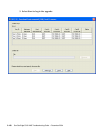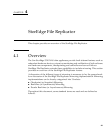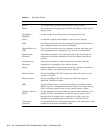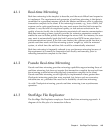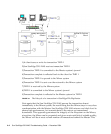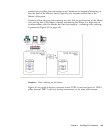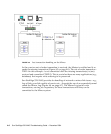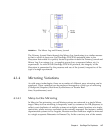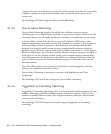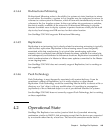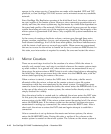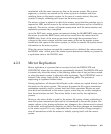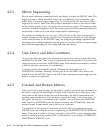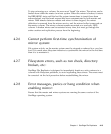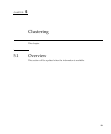
4-8 Sun StorEdge 5310 NAS Troubleshooting Guide • December 2004
systems fails or is lost, the data is preserved at the central, corporate site, providing
a fallback position for the remote locations and expediting the recovery of the
remote site.
Sun StorEdge 5310 NAS supports Many-to-One Mirroring.
4.1.4.2 One-to-Many Mirroring
One-to-Many Mirroring refers to the ability for a Master system to mirror
simultaneously to multiple Mirror locations. It may seem a simple variation on the
mirroring theme, but it actually introduces a number of complexities to mirroring.
A One-to-Many mirror must be able to cope with different QOS levels on the
different connections to remote systems. For example, if a system in Los Angeles is
mirroring Many-to-One to systems in San Francisco and Houston and the link
between Los Angeles and Houston becomes compromised (increased latencies,
packet loss etc.), then the system must decide whether and when to - in the case of
Real-time Mirroring - sever the link with the Houston system to preserve the QOS of
local users. If the Los Angeles system in the prior example employs Pseudo Real-
time Mirroring, then the system must decide how to manage situations where the
mirror buffer is overrun for the San Francisco system, but remains intact for the
Houston system.
Note that QOS policies must typically be decided on and managed by the user,
placing not insignificant burden on them.
One-to-Many Mirroring is frequently confused with Replication and Push
Technology.
Sun StorEdge 5310 NAS does not support One-to-Many mirroring.
4.1.4.3 Piggyback or Cascading Mirroring
Piggyback or Cascading Mirroring refers to a more common implementation of One-
to-Many Mirroring, whereby a Master system mirrors to a Mirror, which in turn
mirrors to another Mirror system (Los Angeles mirrors to Houston, and Houston
mirrors to San Francisco).
Sun StorEdge 5310 NAS does not currently support Piggyback or Cascading
mirroring.



